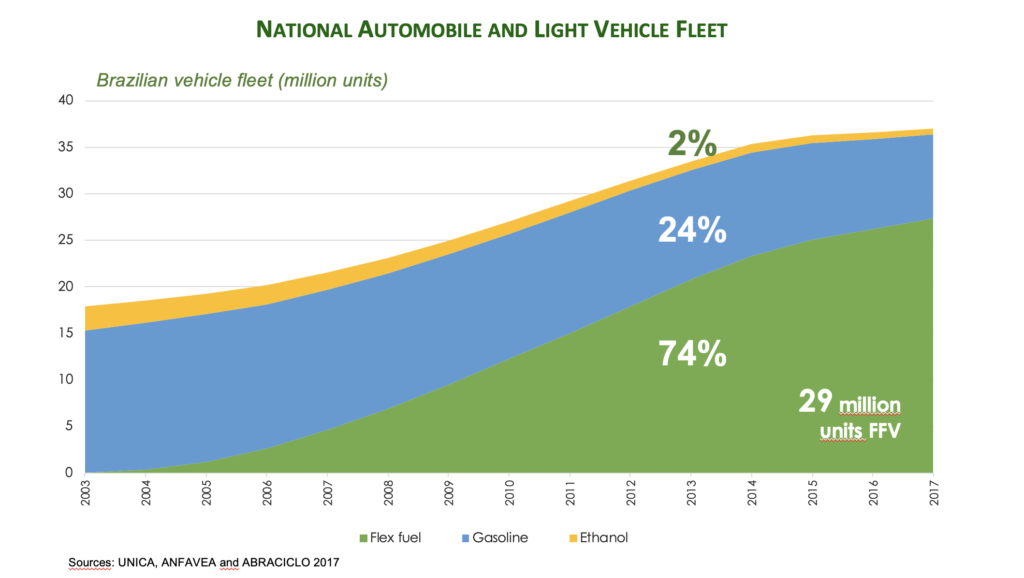Innovative Transportation Fleet
 Brazil has achieved greater energy security thanks to its focused commitment to developing a competitive sugarcane industry and making ethanol a key part of its energy mix. In fact, Brazil has replaced forty-six percent of its gasoline needs with sugarcane ethanol – making gasoline the alternative fuel in that country.
Brazil has achieved greater energy security thanks to its focused commitment to developing a competitive sugarcane industry and making ethanol a key part of its energy mix. In fact, Brazil has replaced forty-six percent of its gasoline needs with sugarcane ethanol – making gasoline the alternative fuel in that country.
Brazil is the world’s largest sugarcane ethanol producer and a pioneer in using ethanol as a motor fuel. In 2018/19, Brazilian ethanol production reached 33.10 billion litres (8.74 billion gallons). Most of this production is absorbed by the domestic market where it is sold as either pure ethanol fuel or blended with gasoline at levels between 18 to 27.5 percent ethanol.
GIVING CONSUMERS A CHOICE
The country first began using ethanol in vehicles as early as the 1920s, and the trend gained urgency during the oil shock of the 1970s. However, sugarcane ethanol’s popularity really took off in 2003 with the introduction of flex fuel vehicles (FFV) that run on either gasoline blends or pure ethanol. FFVs give Brazilian consumers a choice at the pump when they fuel their cars, and most are choosing sugarcane ethanol for its price and environmental benefits
More than 90 percent of new cars sold today in Brazil are flex fuel due to consumer demand, and these vehicles now make up seventy-four percent of the country’s entire light vehicle fleet – a remarkable accomplishment in less than two decades. Currently, 19 automakers offer over 242 models of FFVs in Brazil. Market projections suggest that FFV sales will tend to stabilize at around 90 percent, with the rest being gasoline-powered imported models that do not offer the flex fuel option.
ETHANOL BEFORE FLEX FUEL VEICLES
Ethanol use in Brazil grew sharply in 1975 with the establishment of the National Ethanol Program, known in Portuguese as Proálcool. One year later, ethanol-dedicated pumps started appearing throughout the country. This program initially encouraged the production of ethanol to be blended into gasoline up to a level of 20%. Starting in 1977, Proálcool also promoted the use of pure ethanol (E100) as vehicle fuel. So in the first stages of the program, consumers had to select their choice of fuel when they bought their car.
Since there was an initial resistance from automakers to produce pure ethanol-powered vehicles, the initial strategy for Proálcool was to disseminate the technology for converting gasoline engines to run on ethanol. Although this period spurred some consumer interest in ethanol, demand was modest. Flex fuel vehicles, introduced in 2003, were the game changer.
MOTORCYCLE AND BUSES
In 2009, Brazil became a pioneer when it launched flex-fuel motorcycles. Ten years after launch, flex motorcycles already represent 32% of the fleet. They are also an innovative, low-cost vehicle that could represent an export opportunity.
Ethanol can also sometimes be used as a substitute for diesel, particularly in the sugar-energy sector and in the urban transportation of passengers and cargo, where it is desirable to use clean and renewable fuels. In such cases, the use of ethanol in captive fleets permits the development of technical solutions that are optimized for ethanol. Stockholm, Sweden and São Paulo, Brazil have been on the forefront in the use of ethanol-powered buses for urban transportation.
Despite its indisputable success in Brazil, flex fuel technology is not widely offered in other parts of the world, largely because of the lack of commitment to produce, use and distribute ethanol. The cost of presenting this option to consumers is not high, and consumers will then be able to choose, where available, a renewable fuel of much lower environmental impact compared to any fossil fuel.
You May Also Be Interested In...
Reflections from the FFA: There is no protection in protectionism
WHAT'S NEW
Sugarcane harvest for South Central Brazil for the second half of November 2020 Read on
